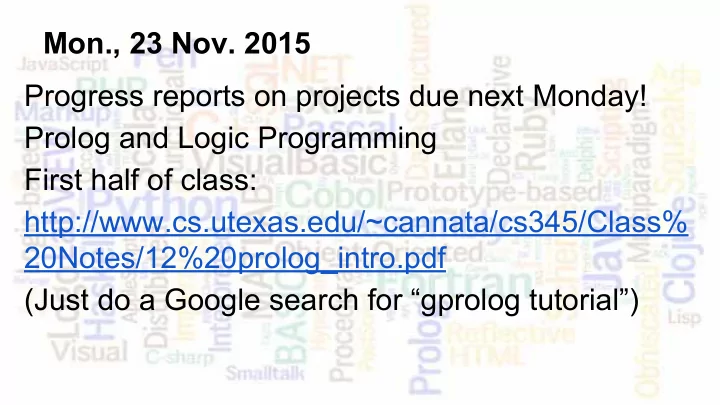

Mon., 23 Nov. 2015 Progress reports on projects due next Monday! Prolog and Logic Programming First half of class: http://www.cs.utexas.edu/~cannata/cs345/Class% 20Notes/12%20prolog_intro.pdf (Just do a Google search for “gprolog tutorial”)
Prolog Background Japan’s “Fifth Generation” project--1982 (https://en.wikipedia.org/wiki/Fifth_generation_computer): “These Fifth Generation computers will be built around the concepts of logic programming.” ● The use of logic to express information in a computer. ● The use of logic to present problems to a computer. ● The use of logical inference to solve these problems.
The Fifth Generation Project “The project imagined a parallel processing computer running on top of massive databases (as opposed to a traditional filesystem) using a logic programming language to define and access the data.” Depending on who you ask, the Fifth Generation project was either “Ahead of its time” or a failure.
Prolog A “program” consists of a database of facts and a set of rules. Facts are expressed as “predicates”--the programmer supplies the meaning. Examples: parent(hank,ben). % “hank is a parent of ben” isa(swan,bird). % “a swan is a bird” required(cs111). % “cs111 is required” prereq(cs111,cs112). eats(unicorn,rose). stooges(moe,larry,curly).
Prolog Constants (“atoms” and names of predicates) begin with lower- case letters; variables are capitalized. Rules specify conditions that must hold for a predicate to be true: grandparent(X,Y) :- parent(X,Z),parent(Z,Y). This means “X is a grandparent of Y if there exists a Z such that X is a parent of Z and Z is a parent of Y.” The symbol “ :- ” should be read as “if” and a comma should be read as “and”.
Prolog A “program” is more like a database of facts and rules; we solve problems by querying this database. Example: beats(spock,rock). beats(scissors,paper). beats(paper,rock). beats(rock,scissors). throws(sheldon,spock). beats(rock,lizard). throws(leonard,lizard). beats(lizard,spock). throws(bernie,paper). beats(spock,scissors). beats(scissors,lizard). throws(amy,rock). throws(howard,scissors). beats(lizard,paper). wins(X,Y):- beats(paper,spock). throws(X,R),throws(Y,S),beats(R,S).
Prolog The last item is a rule: wins(X,Y):- throws(X,R),throws(Y,S),beats(R,S). It should be read as: “X wins over Y if, for some values of R and S, X throws R, Y throws S, and R beats S.” (For those of you with some mathematics background, we would say R and S are “existentially quantified”: “X wins over Y if there exist values R and S such that…”)
Prolog Consult a database named “facts.pl” (ordinary text file in local directory) $ gprolog | ?- [facts]. Pose a query: “For what values of X and Y does X (1 ms) yes win over Y?” | ?- wins(X,Y). X = sheldon System responds with candidate values for variables Y = amy ? ; X and Y X = sheldon Y = howard ? ; Each time “;” is entered, a new search is made; X = leonard when no more solutions are found, system says “no” Y = sheldon ? ; ...
Prolog How does it work? Prolog tries to match the pattern of the query with one of the facts or with the left-hand side of one of the rules. Example: “ wins(X,Y) ” matches the pattern of the left-hand side of rule: wins(X,Y):- throws(X,R),throws(Y,S),beats(R,S). If a fact is found, we’re done, otherwise we recursively query each of the terms in the right-hand side of the rule: “throws(X,R)” and “throws(Y,S)” BOTH match the fact “throws (sheldon,spock)”, but there is no match for “beats(spock, spock)”, so we backtrack to find more matches….
Prolog … and eventually we find a match-up: throws(X,R), throws(Y,S), beats(R,S) throws(sheldon, spock) throws(amy,rock) beats(spock,rock) When a match is made that involves a variable, a BINDING occurs between the variable and the matched item. So, X = sheldon, R = spock, Y = amy, S = rock. Bindings must be consistent.
Prolog This process of matching patterns in queries to patterns of rules and facts is called “unification.” We say that “throws(X,R)” unifies with “throws(sheldon,spock)”.
Recommend
More recommend